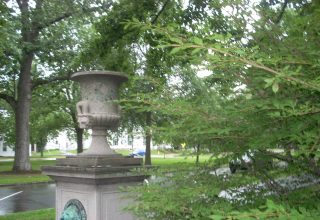
I find that cathedrals and temples are great dwellings for the numinous not just because they are sacred (though this helps), but also because they are filled with many strong sensory experiences: sound, sight, smell, touch and human interaction (often nonverbal). For me, the numinous is found in the Cathedral at Salisbury (near Stonehenge) in England, Notre Dame in Paris, a crumbling temple in Southern Taiwan—and the Jackson Square cathedral in New Orleans. It is actually not so much what happens inside the Jackson Square Cathedral. It’s what happens outside before I enter the cathedral: street musicians, painters, hucksters, tourists, smell of coffee (from Café du Monde and other nearby cafes) and Magnolia blossoms.
My wife, Kathleen, prepared several sketches of the Cathedral towers while sitting on a bench in Jackson Square on a warm day in Spring many years ago—some of the only art she has produced during the past busy decades of her life. Kathleen was multi-tasking in that she was taking in the warmth, sounds, smells and sights of the Square while sketching the Cathedral towers. These other “tasks” inspired her to sketch and influenced what she was representing on paper. As I mentioned above, the experience of the numinous is about the breaking of boundaries between the internal and external. Jackson Square and the Cathedral encourage one to “lose control.” They allow internal and external experiences to intermingle, provoking new ideations that link with old memories and emotions as well as new hopes and aspirations. They encourage a spiritual “assemblage.”
Spirituality as an “Assemblage” of Special Moments
I hold another perspective on spirituality that comes from my colleague, Matt Friedman, who is a reformed Jewish Rabbi. Matt and I happened to be meeting together at the time of the 9/11 collapse of buildings in New York City. I was originally scheduled to take a flight to Los Angeles (from Sacramento) but quickly left the plane when it was reported that the second airplane had crashed into one of the twin towers. I headed off to my graduate school and found Matt Friedman lingering in the school’s lobby—not quite sure what to do given the events of 9/11. My other staff members at the school all went home, leaving Matt and me to watch what was unfolding on a T.V. monitor at the school.
Matt and I shared our own thought about the catastrophe and evil forces manifest in New York City. It was a “blessing” for me to share my thoughts and feelings with someone who had spiritual training. One of the things Matt told me concerned his work with fellow Jews who considered themselves to be “secular” (as I did). Matt indicated that he would ask these “non-believers” to reflect on experiences in their own lives that had been particularly important, disturbing, inspiring or at least intriguing.
Matt would then begin to “assemble” these experiences into something that Matt would call a spiritual or religious foundation. He would help his non-believer identify the values, aspirations – and fears—associated with this assemblage. This was not a matter of somehow “converting” this person and making them believe Judaic dogma or observe Jewish dictates and commandments. Rather, it was a matter of assisting someone make better sense of their life and attending beliefs. I could buy into what Matt was saying and found that 9/11 was an appropriate (though awful) setting for reflecting on and assembling by own belief system.
Download Article 1K Club



















